
Guests
- Ted Shawdirector-counsel and president of the NAACP Legal Defense and Educational Fund.
- Todd Gazianodirector of the Center for Legal and Judicial Studies for the Heritage Foundation.
The Supreme Court recently heard arguments in a pair of cases that could determine whether local governments can take measures to promote racially desegregated schools. We host a debate on school integration with the NAACP Legal Defense and Educational Fund and the Heritage Foundation. [includes rush transcript]
Transcript
AMY GOODMAN: We turn now to the Supreme Court, which recently heard arguments in a pair of cases that could determine whether local governments can take measures to promote racially desegregated schools. Parents of white students in Seattle and Louisville sued their local school districts to challenge policies that considered race as a factor in determining what schools students attend. In both systems, students are offered a choice of schools but can be denied admission if enrolling at a particular school would upset the racial balance. Both desegregation plans were voluntarily enacted by the local school districts.
The court’s conservative majority seemed hostile to the school desegregation plans. The landmark 1954 Brown v. Board of Education case, which ruled segregated schools unconstitutional, was repeatedly brought up as evidence of the strict scrutiny that race-based plans must face.This is Chief Justice Roberts and Justice Scalia in an exchange with the Seattle District’s lawyer, Michael Madden.
MICHAEL MADDEN: Sometimes students in the end of the day have an assignment determined by race. Just like in the university cases, at some point, race will be a tipping factor. What’s different, though, we put someone in a basically comparable school.
CHIEF JUSTICE JOHN ROBERTS: Well, you’re saying—I mean, everyone got a seat in Brown, as well. But because they were assigned to those seats on the basis of race, it violated equal protection. How is your argument that there’s no problem here because everybody gets a seat distinguishable?
MICHAEL MADDEN: Because segregation is harmful. Integration, as this court has recognized in Swann and in the first Seattle case, has benefits.
JUSTICE ANTONIN SCALIA: Well, but—
MICHAEL MADDEN: This district was—
JUSTICE ANTONIN SCALIA: It seems to me you’re saying you can’t make an omelet without breaking eggs. Can you think of any other area of the law in which we say, “Whatever it takes. So long as there’s a real need, whatever it takes”? I mean, if we have a lot of crime out there, and the only way to get rid of it is to use warrantless searches, you know, fudge on some of the protections of the Bill of Rights, “Whatever it takes, we’ve got to do it”?
AMY GOODMAN: That last comment was from Justice Scalia. The Bush administration filed a friend-of-the-court brief for the white parents, challenging the school districts. This is Justice Stephen Breyer responding to Solicitor General Paul Clement, who argued the Bush administration’s position.
JUSTICE STEPHEN BREYER: Go back to Cooper v. Aaron. Go back to the case where this court and paratroopers had to use tremendous means to get those children into the school. That’s because the society was divided. Here, we have a society, black and white, who elect school board members, who together have voted to have this form of integration. Why, given that change in society, which is a good one—how can the Constitution be interpreted in a way that would require us, the judges, to go in and make them take the black children out of the school? So my objection to your approach to the Constitution is primarily a practical one.
AMY GOODMAN: Supreme Court Justice Breyer. Ted Shaw of the NAACP Legal Defense Fund and Todd Gaziano of the Heritage Foundation join us now in Washington, D.C., to debate the issue. Ted Shaw is the director-counsel and president of the NAACP Legal Defense and Educational Fund. Todd Gaziano is director of the Center for Legal and Judicial Studies for the Heritage Foundation. We welcome you both to Democracy Now! and begin with Todd Gaziano. Your assessment of this case?
TODD GAZIANO: Well, this case really follows very much the principles of Brown v. Board of Education, that school districts’ theories of the right racial mix is really a very dangerous one that the court needs to apply very strict scrutiny. And I should add that it wasn’t just white parents and white students who were denied the school of their choice. It was minority parents, over 100 in the Seattle school district. A third of those denied were told that they couldn’t go to the high school of their choice, because it would make that school too minority in the view of some education bureaucrat. That’s the kind of practice that we thought Brown v. Board of Education ended, and I think that’s what the Supreme Court is going to say.
AMY GOODMAN: Ted Shaw, what’s your assessment of this case?
TED SHAW: Brown v. Board of Education wasn’t about bureaucrats. Brown v. Board of Education was about a rigid system of segregation that followed from the Plessy v. Ferguson decision. It was about people being denied admission to schools because of their race, absolute segregation based upon the belief of racial superiority and inferiority.
This case is about the last gasp of Brown v. Board of Education. Mandatory desegregation is all but dead. All that’s left is voluntary integration efforts by school districts that want to maintain desegregated schools. And the fact is that the only way that’s going to happen is if school districts are allowed to pursue it. To equate segregation with attempts to integrate is simply a false equation. It’s a hijacking of the principles of Brown, standing it on its head, and a perversion of the 14th Amendment’s Equal Protection Clause.
AMY GOODMAN: What about Todd Gaziano’s comment, Ted Shaw, that we’re not only talking about white students saying they can’t go to the school of their choice, but black students, as well?
TED SHAW: Well, two points. One is that school districts around this country routinely assign students to school, and most school assignments are not done on a voluntary basis, that is to say, with choice, although school districts are increasing choice opportunities. But the phenomenon that he’s talking about is part of the most uncontroversial desegregation efforts. And that is to say, if you have majority to minority transfer provisions like school districts did, that allowed students, if their race is in the majority, to transfer to schools in which they were in a minority, that was integrative.
And they did not allow the opposite, that is, segregative assignments. That’s the principle here. If an assignment is going to be segregative, then they may say no, because we value integrated education. That’s an assignment that’s not available to you, make another choice that is integrative. If it’s integrative, then it’s OK. So, it is not based upon the belief that any student is inferior. It doesn’t stigmatize. It’s about trying to maintain integrated education. And frankly, you can’t do it any other way.
AMY GOODMAN: Todd Gaziano of Heritage Foundation, your response?
TODD GAZIANO: Well, I’m not sure what a lot of that means, that it doesn’t harm the students or the parents who are denied the school of their choice. This is the fact of these so-called voluntary integration plans. They set these very hard quota bans. And if you’re an Asian student, you’re considered white in one district, you’re considered a minority in the other. And the fact of the matter is, there are these rigid bans, and if you’re a minority parent, you may get in some schools, if you’re a minority parent or child, you won’t get in others, and it will be exclusively on the basis of race. You know, Justice Kennedy said it’s like saying everyone gets a meal. Everyone gets a meal. It’s just that some get dessert, and some don’t. Everyone gets to, you know, a school, just like in Brown, but some get their choice, and some are told, because of their race, they can’t go to the school of their choice. That’s discrimination. It’s not a special kind of discrimination. It’s the same kind of discrimination.
AMY GOODMAN: Todd Gaziano, do you see a trend here? You have Michigan voters recently approving a constitutional amendment banning affirmative action in public employment, public education and state contracting. It was called the Michigan Civil Rights Initiative, pushing proposal to prohibiting preferential treatment based on race, gender, color, ethnicity or national origin.
TODD GAZIANO: Well, it’s very encouraging that Americans, you know, for some time, have been rejecting racial discrimination in all its forms, rejecting racial quotas, rejecting racial preferences. It’s only some government bureaucrats who think they know the exact percentage of schools that are the problem. In these school districts, for example, there’s no question they would all be integrated. In Seattle, for example, all this manipulation only results in about 2 percent change, one way or the other. And it’s for that reason that the bureaucrats want to force parents to make these—or to reject their choices. But it’s great that the people are rejecting that kind of nonsense.
AMY GOODMAN: Ted Shaw of the NAACP Legal Defense and Education Fund, same question about the Michigan anti-affirmative action referendum that was just passed, as well as this case.
TED SHAW: Let me make two points. First of all, let me throw away—I think we should throw away all these buzzwords that Todd knows triggers a certain kind of reaction: bureaucrats, quotas, etc. This isn’t about that. This is about whether or not we’re going to continue to make progress on issues of race in this country. And what our adversaries have done is hijacked the language of the civil rights movement, like in the Michigan Civil Rights Initiative, and they are advocating a kind of color blindness, which is, again, a hijack of the term “color blindness.” What they’re really doing is trying to gouge out our eyes so we can’t do anything about continued racial inequality, which is still existing as a consequence of our long history of discrimination, particularly against African Americans. Let me make no mistake about this. The edge on all of this is still along the black-white divide, even though we’re a multi-racial society and everybody’s affected by it.
The Michigan Civil Rights Initiative is going to mean that the government in Michigan, the University of Michigan, will not be able to make efforts to enroll minority students on a conscious basis, will not be able to try to get minorities involved in contracting, where they are underrepresented. And this is part of a much larger effort to make it illegal and unconstitutional in this country to voluntarily and consciously do anything about racial inequality. That’s their bottom line.
So at the end of the day, whether we’re talking about scholarships for minority students, pipeline programs into corporate America, programs that are outreach to get people involved in opportunities they otherwise wouldn’t have, they’re on the chopping block, in crosshairs of these right-wing ideologues. And what they’re trying to do is stop all voluntary attempts to do anything about racial inequality in this country. That’s the bottom line. We should be clear about it.
AMY GOODMAN: And Justice David Souter’s comment that school systems must hide the ball to seek racial diversity without relying on race, Ted Shaw?
TED SHAW: Well, you know, Justice Souter was pointing out, too, that there’s a kind of an anomalous part of these arguments or even a hypocrisy. That is to say, our adversaries tell us that you can do this in any other way, but you cannot do it because of race, because race becomes this third rail, given our experience. Well, you’re telling African Americans who were at the butt end of slavery and segregation, that only ended—desegregation—four decades ago in any serious way, that race is a third rail and therefore you cannot consider race, even if it means consideration of race to address continued racial inequality.
Justice Souter was saying, “Look, let’s not play games. We should honestly and openly be able to address racial inequality, and the only way you can do that with certainty is to do it consciously, and to equate racial integration efforts with racial segregation is a dishonest, dishonest approach.” And he doesn’t any part of it, and neither should the American people.
AMY GOODMAN: Let me put this question to Todd Gaziano of Heritage Foundation. Looking at an AP piece about how this issue presents a unique challenge to Louisville schools, which spent a quarter of a century under a court order to eliminate the effects of state-sponsored segregation. The Jefferson County, Kentucky, school board, which encompasses Louisville, decided to keep much of the court-ordered plan in place to prevent schools from segregating again. Ruth Bader Ginsburg, the Supreme Court justice, said, “What’s constitutionally required one day is constitutionally prohibited the next. That’s very odd,” she said, a sentiment shared by three of her liberal colleagues. Your response?
TODD GAZIANO: Well, school districts, of course, have a requirement to remedy their past discrimination, and when, after many decades, a school system like Louisville is told that they have remedied the government’s intentional discrimination, they can’t then, you know, play by special rules and deny—as I say, minority parents and white parents, Asian parents, Hispanic parents, that they’re going to continue their social engineering plan.
What they were doing in Louisville was denying minority parents the choice. You can’t create a system of choice and then say this minority parent’s going to get their choice of school, this minority parent isn’t. This Hispanic parent and child is going to get their choice, this Asian parent is not. That’s the same type of discrimination in the old system. It’s just a new theory. And the courts need to be equally skeptical of all uses of race. And this is what the school boards need to do: The school boards need to be required to bring up all schools, so that parents will not be so passionate about trying to get to one school over another. That’s the real challenge of America today.
AMY GOODMAN: Ted Shaw, we just have 10 seconds.
TED SHAW: Yeah, I would agree with the last point, although, with all due respect, Todd has made a number of misrepresentations in both cases. The bottom line is that Brown wasn’t about desegregating schools for a moment when the courts can take a snapshot and then allowing them to return to segregation. That’s what his argument and the arguments of our opponents allow these school districts to do. And the equation of segregation and integration as the same thing is fundamentally wrong.
AMY GOODMAN: We’re going to leave it there. Ted Shaw of NAACP Legal Defense and Educational Fund, Todd Gaziano of the Heritage Foundation, thanks so much for being with us.

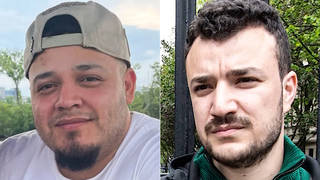

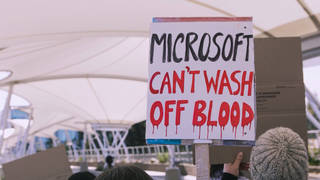
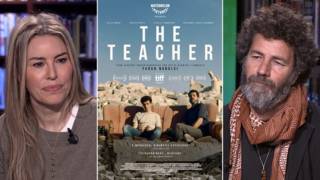





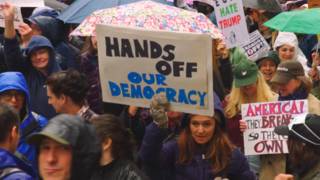
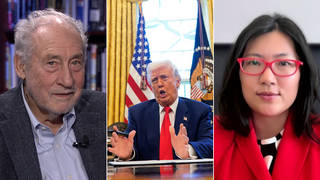
Media Options